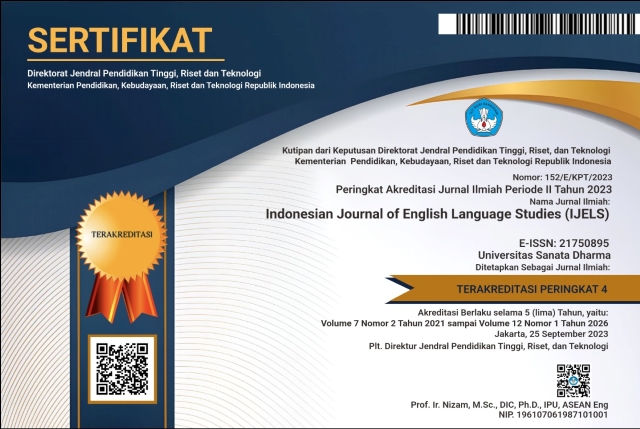Corrective Feedback and Learner Uptake in a Young Children Bilingual Classroom
(1)
(*) Corresponding Author
Abstract
Most research on corrective feedback and learner uptake inspired by Lyster and Ranta (1997) has been conducted with students belonging to various age groups. This study was undertak- en to investigate the occurrence of corrective feedback and uptake in young children bilingual context whose age ranged from 5 to 6 or children in bilingual kindergarten in Indonesia. Transcripts of 100 minutes of lessons in Blossoms class of Satya Wacana Children Centre, Salatiga, were analyzed to answer these two research questions: (1) What types of learner er- rors lead to what types of corrective feedback in young children bilingual classroom? and (2) what is the uptake rate of each type of feedback and the relationship between learner errors, feedback, and learner uptake? The results revealed that the majority feedback provided for grammatical errors was repetition. The majority feedback given on phonological errors was recast. Then, explicit correction was the most frequent feedback for lexical errors. This study also found that elicitation and repetition led to the highest uptake rate. Although recast in this study did not lead to a high uptake rate compared with other types of feedback, in the case of phonological errors, recast did lead to a high uptake and repair rate. This study also provided an integrated picture about the relationship between learner errors, feedback, and learner up- take. Overall, there were differences in the patterns of feedback and uptake between this study and previous studies, which were interpreted with the reference to the unique character- istics of the instructional context.
Keywords
Full Text:
PDFReferences
Choi, S. Y., & Li, S. (2012). Corrective Feedback and Learner Uptake in a child ESOL Classroom. RELC Journal, 43:331.
Cummins, Jim. (2000). [Online] Educational research in bilingual education. Available: http://www.iteachilearn.com/cummins/ educationalresearch.html
Ellis, R., Basturkmen, H., &Loewen, S. (2002). Doing focus on form. Sys-tem 30:419-432.
Ellis, R. (2008). The Study of Second Lan-guage Acquisition. Oxford: Oxford University Press.
Ellis, R. (2010). A Framework for Investi-gating Oral and Written Corrective Feedback. Studies in Second Lan-guage Acquisition, 32:335-349.
Gass, S. (1997). Input, Interaction, and Sec-ond Language Learner. Mahwah, NJ: Erlbaum.
Loewen, S., Philip, J. (2006). Recast in adult English L2 classroom: charac-teristics, explicitness, and effective-ness. The Modern Language Journal 90(4):536-556.
Lyster, R. (1998). Negotiation of form, re-cast, explicit correction in relation to error types and learner repair in immersion classrooms. Language Learning 48(2):183-218.
Lyster, R. (2001). Negotiation of form, re-cast, explicit correction in relation to error types and learner repair in immersion classrooms. Language Learning 51(supplement 1): 265-301.
Lyster, R. (2004) Differential effects on prompts and recast in form-focused instruction. Studies in Second Language Acquisition 28:269-432
Lyster, R., & Saito, K. (2010). Oral feedback in classroom SLA. Studies in Second Language Acquisition 32:265-302.
Sheen, Y. (2006). Exploring the Relationship between Characteristics of Recast and Learner Uptake. Language Teaching Research, 10:361.
Suzuki, M. (2005). Corrective Feedback and Learner Uptake in Adult ESL Classrooms. Columbia University Working Papers in TESOL & Applied Linguistics, Vol.4, No. 2.
Swain, M. (1995) Three functions of output in second language learning. In: Cook G, Seidlhofer B (eds) Principles & Practice in Applied Linguistics: Studies in Honour of H.G. Widdowson. Oxford: Oxford University Press, 125-144.
Richards, Jack C., John Platt and Heidi Platt. (1992). Dictionary of language teaching and applied linguistics. Essex: Longman Group UK Ltd.
Tsang, W. K. (2004). Feedback and Uptake in Teacher-Student Interaction: An analysis of 18 English Lessons in Hong Kong Secondary Classrooms. RELC Journal, 35:187.
DOI: https://doi.org/10.24071/ijels.v4i2.2307
Refbacks
- There are currently no refbacks.

This work is licensed under a Creative Commons Attribution-ShareAlike 4.0 International License.
IJELS Journal Sinta 4 Certificate (S4 = Level 4)
We would like to inform you that Indonesian Journal of English Language Studies (IJELS) has been nationally accredited Sinta 4 by the Ministry of Education, Culture, Research and Technology of the Republic of Indonesia based on the decree No. Surat Keputusan 152/E/KPT/2023. Validity for 5 years: Vol 7 No 2, 2021 till Vol 12 No 1, 2026

This work is licensed under CC BY-SA.
Creative Commons Attribution-ShareAlike 4.0 International License
IJELS e-ISSN 2715-0895; IJELS p-ISSN 2442-790X
Indonesian Journal of English Language Studies (IJELS) is published twice a year, namely in March and September, by the English Language Studies (ELS) of the Graduate Program of Sanata Dharma University, Yogyakarta, Indonesia.


 IJELS p-ISSN:
IJELS p-ISSN: 









